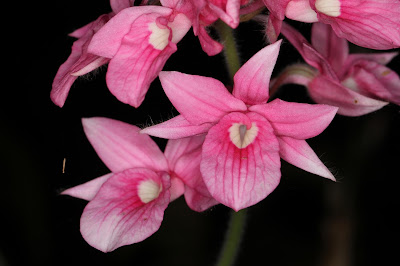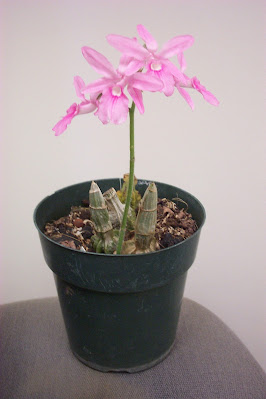Calanthe rosea - Pink Calanthe flowers are 5-7 cm of diameter with similar sepals and petals of pink colour, and flat labellum, of more intense pink..
Calanthe rosea also called as Pink Calanthe, Limatodis rosea, Preptanthe rosea, is a species of the genus Calanthe. This species was described by George Bentham in 1881.
DESCRIPTION OF CALANTHE ROSEA - PINK CALANTHE
Calanthe rosea is native to Southern Myanmar to Thailand, Philippines. This orchid is found in the forests in zones characterized by a marked seasonal climate, particularly rainy in spring-summer, dry in autumn-winter of Myanmar, Philippines, Thailand at elevations of 300-900 meters above sea level.
It is a small sized, deciduous, hot growing terrestrial orchid with elliptic to fusiform, narrowing in the middle, 6-8 cm long or more pseudobulbs. The leaves are oblong-lanceolate, plicate, glabrous, up to about 30 cm long.
Pink Calanthe blooms in fall and winter from the erect, 40-75 cm long, erect then arching, pubescent, many flowered inflorescence with 10 to 30 flowers held in a loose raceme that occurs after the fall of the leaves, from the base of the pseudobulb and before the new leaves begin to appear. The flowers are 5-7 cm of diameter with similar sepals and petals of pink colour, and flat labellum, of more intense pink colour, and white throat.
CALANTHE ROSEA - PINK CALANTHE CARE
Cultural information should only be used as a guide, and should be to be adapted to suit you. Your physical location; where you grow your plants, how much time you have to devote to their care, and many other factors, will need to be taken into account. Only then can you decide on the cultural methods that best suit you and your plants.
Light:
Calanthe rosea needs a light level of 20000-30000 lux. The light should be bright but filtered or dispersed, and the plants should never be exposed to the direct sunlight of the midday sun. Strong air movement should be ensured all the time.
Temperature:
The average temperature of the day is 29-32 ° C, the night 23 ° C, and the daily difference is 6-9 °C. In winter it needs maximum luminosity, but not direct sun, with night temperatures of 15-18 °C, even if it can resist to exceptional, and for a very short time, lowering up to some degrees over the 0 °C.
Humidity:
Pink Calanthe needs the humidity of 80-85% from spring to autumn; and at the end of autumn and winter it drops to 70-75%.
Substrate, growing media and repotting:
Calanthe rosea require a fertile, perfectly permeable substrate. You can use a mixture of 1 part of fertile clay soil, 1 part of well-fermented manure, 1/2 part of cut osmunda fern and 1/2 part of chopped tree fern fiber or a mixture consisting of 6 parts of fine bark, 1 part of pearlite or pumice, and 3 parts of peat mixed with live moss sphagnum. One part of charcoal can be added to each of the aforementioned mixtures, which improves the airiness of the substrate and prevents it from getting sour. After reaching maturity, they lose their leaves, and then grows inflorescence. It also recommends reducing or even stopping watering when the plants bloom.
After flowering, the plants should be removed from the pots, pseudobulbs cleaned, and all old roots removed. The plants should be divided into individual pseudobulbs and then for the winter season located without roots in a cool, dry place. When new growths reach a height of about 5 cm in spring, they should be planted again. These plants should be split and repotted each year, because this ensures the creation of flowers.
Watering:
Pink Calanthe should be abundantly watered during active growth, but excellent drainage and aeration of the substrate must be ensured, which can never be soggy or damp. Precipitation in a natural habitat is abundant from mid-spring to autumn. Then their number drops sharply and there is a dry season, lasting from late autumn until the beginning of spring.
Fertilizer:
It is recommended to use 1/2-3/4 of the recommended dose of fertilizer for orchids in the growing season every week. These orchids require high doses of fertilizers. You can use sustainable fertilizer throughout the year, but also can use high-nitrogen fertilizer from spring to mid-summer, and then until the end of autumn, high-phosphoric fertilizer.
Rest period:
Calanthe rosea shed all or most of their leaves at the beginning of the rest period. In the winter and at the beginning of spring, the amount of water should be significantly reduced or even eliminated during flowering, and then you should stop watering until the spring appears new increments when the plants are repotted. Fertilization should be eliminated until new growths appear and spring watering begins in the spring.















COMMENTS